 Kids' Club Spanish School, LLC
https://kidsclubspanishschool.com/wp-content/uploads/2024/07/blog_summer-spanish-activities-for-kids-3.png
807
800
Alexis Fishbaugh
https://cdnwp.kidsclubspanishschool.com/wp-content/uploads/2025/05/kids-club-spanish-school-header-logo.webp
Alexis Fishbaugh2024-07-28 22:48:532024-07-28 22:48:53Summer Spanish Activities for Kids
Kids' Club Spanish School, LLC
https://kidsclubspanishschool.com/wp-content/uploads/2024/07/blog_summer-spanish-activities-for-kids-3.png
807
800
Alexis Fishbaugh
https://cdnwp.kidsclubspanishschool.com/wp-content/uploads/2025/05/kids-club-spanish-school-header-logo.webp
Alexis Fishbaugh2024-07-28 22:48:532024-07-28 22:48:53Summer Spanish Activities for KidsSPANISH CHRISTMAS FOR CHILDREN
How do Children in Spain Celebrate Christmas?
¡Feliz Navidad! The Christmas season is a special event all around the world, and it brings happiness, joy and excitement to many but especially to children. In Spain, The Christmas season is celebrated with family, and it includes more than just one special day. There are many different Spanish Christmas activities for children. Food, decoration, parades, gifts, songs, and dances are a big part of the tradition. Spanish Christmas for children is truly a special time.
The Christmas season in Spain is filled with a lot of conventional activities and customs that are observed in almost every corner of the world, and Spanish children are not left out of this joyous event celebrated once a year however, even though Christmas in Spain is celebrated on December 25th, the season extends from the beginning of December until the 6th of January, due to different holidays and the various activities that come with them.
“Is it not enjoyable to learn and practise what you learn?“
– Confucius
The Day of the Immaculate Conception – The Kick-off to the Spanish Christmas Season for Children.
This holiday celebrates the Roman Catholic belief of The Blessed Virgin Mary’s immaculate conception in her mother’s womb and is considered the first official day of Christmas celebrations for many people in Spain. On December 8th religious songs and dances are performed that welcomes the beginning the season. Musical groups, including children groups, gather in traditional attire to sing while the children dance ‘Danza de los Seises’. This is also when most of the Christmas atmosphere begins to appear around towns and cities. Christmas markets are opened in major squares that sell Christmas decoration materials, ornaments, food, and gift items. Families can buy these goods in the markets and children, as always, take part in the decorations after the shopping spree. Houses and cities are colorfully decorated from this time onwards, and the excitement and anticipation of other various activities begin.
While Santa Claus does make an appearance in Spain, as in other countries, he is not as important.
Christmas Eve Dinner (Nochebuena)
December 24th ushers in the birth of Jesus Christ, Christmas Eve (Nochebuena in Spanish), and in many countries, this is the day that most families around the world exchange gifts. In Spanish Christmas, children must wait for, the major part of the gifts, a little longer.
Spanish Christmas Eve dinner is held on this day as the biggest meal of the season, where traditional meals including lobster, lamb, suckling pig, fish stew, soup, cheese, hams, pates and a lot of seafood are part of the cuisines served at Spanish Christmas eve dinner. For dessert the typical Turrón is present, which is a sugary nougat that comes in many different forms and varieties. Most families serve big plates full of many different types of Turrón so this is fun for the Spanish children to try each kind.
One tradition that has been part of Spanish Christmas since 1975 is the speech that the King of Spain gives, aired on every TV channel in Spain, on Christmas Eve. The King speaks about the main issues that the country faced the previous year and provides encouragement for the people wishing them all a very merry Christmas. It is very typical tradition for the whole family to sit around the television set to watch together.
Christmas Day (Navidad)
December 25th is Christmas Day (Navidad) in Spain. It is a day when families get together for a big lunch, eat well, and spend time with each other. As with Christmas Eve, this is typically a day for all the gifts, but in some families, children may receive a small gift either on Christmas Eve or during the morning of Christmas Day.
While Santa Claus does make an appearance in Spain, as in other countries, he is not as important. There are other characters that play the part that Santa Claus plays in other parts of the world, in some parts of Spain, such as Olentzero, a coal mining man who lives in the Basque Country, the North of Spain, and comes down to the mountains to deliver gifts to children. And in Catalonia the “Caga Tió” is a log that is filled with presents for the children to break open and enjoy.
Having a Christmas tree in the house for Christmas is a relatively new concept and more of an Anglo-Saxon tradition that has slowly been adopted. However, the “Belén” or a nativity scene is a typical Spanish household staple for Christmas. They can be very extensive and elaborate, and can sometimes include hundreds of little characters depicting not just the nativity scene in the barn, but the entire village and sometimes the neighboring villages as well. This differs from other parts of the world where the nativity scene consists in just the holy nuclear family.
This is where Spanish Christmas for children can get a bit strange. The “Caganer”, is a Catalonian tradition, where a figure of a man taking a “poo” in a barn is placed in a corner of the nativity scene behind a bush. As strange as this tradition might seem to an outsider’s eyes, it represents the fertilization of the the earth, and is a symbol of prosperity and good luck.
New Year’s Eve (Nochevieja)
On New Year’s Eve, fireworks, parties, and an exciting atmosphere are always present, like in many other countries. However, it is more of a family affair than in most places. People usually spend time at home with their families right before the year changes. A dinner with family and friends is an important part of this day as well. The countdown takes place as a family, and kids can enjoy different party favors, setting off fire crackers and watching the local village or neighbor’s fireworks. During the New Year’s Eve, there is a popular tradition which includes eating grapes one by one, in time with the striking of the clock, at midnight on 31 December. If you manage to eat all the grapes in time, you are in for a year of prosperity and good luck. These grapes are called “the grapes of luck” or “las uvas de la suerte”. Eating 12 grapes in time with the toll of the clock, is not as easy as it sounds, especially since these grapes are not like the typical grapes you may be accustomed to, as they have a pit that must be ate around. It is fun for the Spanish children to see their family member’s cheeks full of grapes and makes for a funny scene.
During the New Year’s Eve, there is a popular tradition which includes eating grapes one by one, in time with the striking of the clock, at midnight on 31 December. If you manage to eat all the grapes in time, you are in for a year of prosperity and good luck.
New Year’s Day (Año Nuevo)
This is a day spent with family eating a big lunch and talking about what the New Year might bring. A typical tradition for this day is to eat the “Coin Soup”, which is really a lentil soup. The round lentils represent coins and eating this soup brings Spanish people wealth in the coming year.
The Three Kings Day (Día de Reyes)
After the Christmas and New Year festivities are over, the beginning of the new year is a time when the kids anticipate what is said to be the most important day of the season to them, January 6th, The Three Kings Day.
The celebration of the Día de Reyes is synonymous with the biblical description of the uniqueness of the birth of Jesus, which is recorded in the book of Mathew. This is the story where the three wise men followed the star to Bethlehem to visit Jesus and presented him with three types of gifts, gold, frankincense, and myrrh. Día de Reyes has since then become a tradition in Spain where the children write letters to one or all three of the wise men; Melchor, Gaspar, and Baltasar, informing them of their excellent behavior throughout the year and the kind of gift they deserve on January 6th. It is believed that the better a child has behaved, the better the gift they will receive.
Epiphany is celebrated 12 days after Christmas on 6th January (or January 19th for some Orthodox Church who have Christmas on 7th January) and is the time when Christians remember the Three Kings who visited Jesus.
The three kings travel on a camel from the East to visit all children in Spain. They arrive in Spain and go from village to village listening to children’s requests and collecting their letters. On January 5th, the Spanish children attend the Three Kings’ parade on the street in a colorful celebration. They then clean their shoes and place them in a place where the kings could see it when they visit their homes at night to distribute the gifts. Families also leave water, turrón (the typical Christmas nougat), and milk out for the kings and their camels in compensation for their hard work of the 5th and 6th of January. On the 6th of January, children get up early and rush to the spot where they placed their shoes to see what gifts the kings have given in exchange for the good behavior they wrote about in their letters. They are glad to see that the water and milk and nougat have been eaten, which of course, means that the kings visited and recovered their strength to return to their home and are preparing for next year’s visit. Between the outdoor activities, parades and receiving their gifts from the kings, January 6th, is considered one of the most exciting times during the season for Spanish children.
On this same day, there is plenty of eating and drinking involved. One of the centerpieces of this day is called the “Roscón de Reyes“, a circular cake made of dried fruits of multiple varieties and sprinkled with sugar on top. A small porcelain plastic jar containing beans (usually called a monarch) is hidden inside the cake. Whoever finds the jar will eat the beans and pay for Roscón the following year. It is believed that such a person will have the whole following year filled with happiness.
The January 6th in Spain is very different when comparing it to many other countries that celebrate the Christmas season. In other countries, Epiphany, as it is known, is not even a public holiday and is mostly only celebrated around Church services, but in Spain, due to this county’s deep Catholic roots, this day is even more important than Christmas Day, especially for Spanish children as this is when they receive their gifts!
There are other characters that play the part that Santa Claus plays in other parts of the world, in some parts of Spain, such as Olentzero, a coal mining man who lives in the Basque Country, the North of Spain, and comes down to the mountains to deliver gifts to children.
In conclusion, we can say that the Christmas season is quite different in Spain compared to other parts of the world. Spanish Christmas for children has been shaped by people, history, and culture into a very unique experience. It is important to spend time with your family, and take part in all the fun traditions. Christmas, for Spanish children, is an exciting time filled with yummy food and gifts. So if you are ever in the neighborhood, come enjoy the food, company and the absolute wonderful atmosphere of the Spanish Christmas season!
Prepare your children to spend Christmas in Spain with our immersive Spanish classes and get a free trial class by registering at Kids’ Club Spanish School!
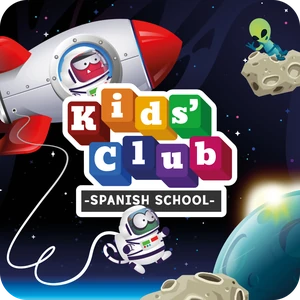
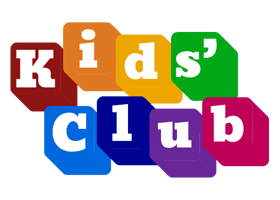





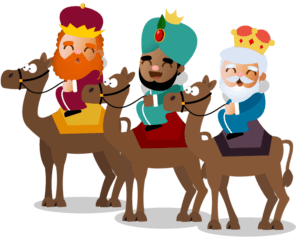

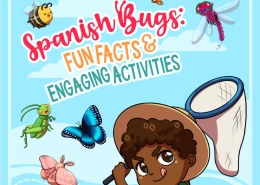 Kids' Club Spanish School, LLC
Kids' Club Spanish School, LLC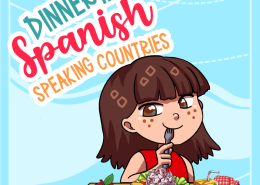 Kids' Club Spanish School, SL
Kids' Club Spanish School, SL Kids' Club Spanish School, LLC
Kids' Club Spanish School, LLC

